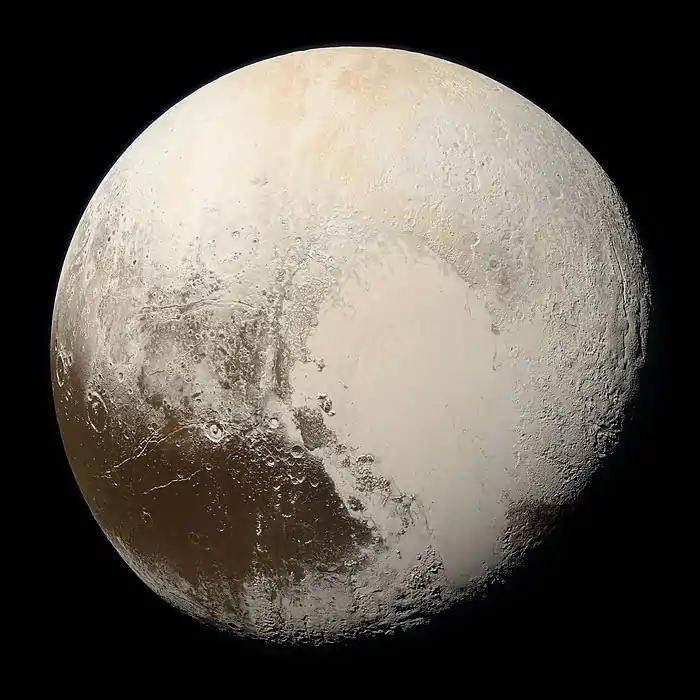(90568) 2004 GV9
(90568) 2004 GV9 is a trans-Neptunian object that was discovered on April 13, 2004 by NEAT.[1] It has been listed as a cubewano by the Minor Planet Center.[2]
 Hubble Space Telescope image of 2004 GV9, taken on March 2010 | |
| Discovery[1] | |
|---|---|
| Discovered by | NEAT |
| Discovery date | 13 April 2004 |
| Designations | |
| 2004 GV9 | |
| Cubewano (MPC)[2] Extended (DES)[3] | |
| Orbital characteristics[4] | |
| Epoch 13 January 2016 (JD 2457400.5) | |
| Uncertainty parameter 2 | |
| Observation arc | 22031 days (60.32 yr) |
| Earliest precovery date | 21 December 1954 |
| Aphelion | 45.618 AU (6.8244 Tm) |
| Perihelion | 38.7281 AU (5.79364 Tm) |
| 42.173 AU (6.3090 Tm) | |
| Eccentricity | 0.081681 |
| 273.88 yr (100034 d) | |
| 34.6030° | |
| 0° 0m 12.956s / day | |
| Inclination | 21.9718° |
| 250.6142° | |
| 293.200° | |
| Earth MOID | 37.7917 AU (5.65356 Tm) |
| Jupiter MOID | 33.6786 AU (5.03825 Tm) |
| Physical characteristics | |
| Dimensions | 680±34 km[5] |
| 5.86 h (0.244 d) | |
Sidereal rotation period | 5.86 h[4] |
| 0.077+0.0084 −0.0077[5] | |
| BR[5] B−V=0.95, V−R=0.52[6] B0−V0=0.843[7] | |
| 19.9[8] | |
| 4.25±0.04[5] 4.0[4] | |
Brown estimates that is very likely a dwarf planet.[9] A diameter of 680±34 km has been determined from combined observations of the Herschel and Spitzer space telescopes.[5] Tancredi notes that light-curve-amplitude analysis shows only small deviations, suggesting that (90568) 2004 GV9 could be a spheroid with small albedo spots and hence a dwarf planet.[10] However, its low albedo suggests it has never been resurfaced and thus is unlikely to have planetary geology.
It has been observed forty-seven times, with precovery images back to 1954.[4]
References
- Spahr, Timothy B. (2004-04-14). "MPEC 2004-G32 : 2004 GV9". IAU Minor Planet Center. Harvard-Smithsonian Center for Astrophysics. Retrieved 2010-01-06.
- "MPEC 2009-R09 : Distant Minor Planets (2009 SEPT. 16.0 TT)". IAU Minor Planet Center. 2009-09-04. Retrieved 2009-10-04.
- Marc W. Buie. "Orbit Fit and Astrometric record for 90568" (2004-06-09 using 46 of 47 observations). SwRI (Space Science Department). Retrieved 2009-10-04.
- "JPL Small-Body Database Browser: 90568 (2004 GV9)" (2011-04-11 last obs). Retrieved 7 April 2016.
- Vilenius, E.; Kiss, C.; Mommert, M.; et al. (2012). ""TNOs are Cool": A survey of the trans-Neptunian region VI. Herschel/PACS observations and thermal modeling of 19 classical Kuiper belt objects". Astronomy & Astrophysics. 541: A94. arXiv:1204.0697. Bibcode:2012A&A...541A..94V. doi:10.1051/0004-6361/201118743.
- Tegler, Stephen C. (2007-02-01). "Kuiper Belt Object Magnitudes and Surface Colors". Archived from the original on 2006-09-01. Retrieved 2009-12-30.
- David L. Rabinowitz; Bradley E. Schaefer; Martha W. Schaefer; Suzanne W. Tourtellotte (2008). "The Youthful Appearance of the 2003 EL61 Collisional Family". The Astronomical Journal. 136: 1502–1509. arXiv:0804.2864. Bibcode:2008AJ....136.1502R. doi:10.1088/0004-6256/136/4/1502.
- "AstDys (90568) 2004GV9 Ephemerides". Department of Mathematics, University of Pisa, Italy. Retrieved 2009-10-06.
- Michael E. Brown. "How many dwarf planets are there in the outer solar system? (updates daily)". California Institute of Technology. Retrieved 30 August 2016.
- Tancredi, G., & Favre, S. (2008) Which are the dwarfs in the Solar System?. Depto. Astronomía, Fac. Ciencias, Montevideo, Uruguay; Observatorio Astronómico Los Molinos, MEC, Uruguay. Retrieved 10-08-2011
This article is issued from Wikipedia. The text is licensed under Creative Commons - Attribution - Sharealike. Additional terms may apply for the media files.
_(cropped).jpg.webp)
